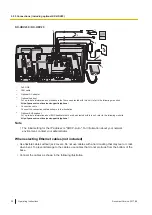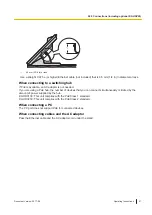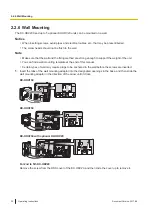
PTC General Warning
The grant of a Telepermit for any item of terminal equipment indicates only that Telecom has accepted that
the item complies with minimum conditions for connection to its network. It indicates no endorsement of the
product by Telecom, nor does it provide any sort of warranty. Above all, it provides no assurance that any
item will work correctly in all respects with another item of Telepermitted equipment of a different make or
model, nor does it imply that any product is compatible with all of Telecom’s network services.
The Use of IP Networks through the PSTN
Internet Protocol (IP) by its nature introduces delay into speech signals as each data packet is formulated
and addressed. Telecom Access Standards recommends that suppliers, designers and installers using this
technology for calls to or from the PSTN refer to ITU E Model requirements in the design of their networks.
The overall aim is to minimize delay, distortion and other transmission impairments, particularly for those
calls involving cellular and international networks, which already suffer extensive delay.
Echo cancellation
Echo cancelers are not normally required in the Telecom PSTN because geographic delays are acceptable
where CPE return loss is maintained within Telepermit limits. However, those private networks making use
of Voice over IP technology are required to provide echo cancellation for all voice calls. The combined effect
of audio/VoIP conversion delay and IP routing delay can cause the echo cancellation time of ≥64 ms to be
required.
Important Notice
•
Under power failure conditions this appliance may not operate. Please ensure that a separate telephone,
not dependent on local power, is available for emergency use.
•
No “111” or other calls can be made from this device during a mains power failure.
1.3.6 For Users in the United States
Note
•
This equipment has been tested and found to comply with the limits for a Class B digital device,
pursuant to Part 15 of the FCC Rules. These limits are designed to provide reasonable protection
against harmful interference in a residential installation. This equipment generates, uses, and can
radiate radio frequency energy and, if not installed and used in accordance with the instructions, may
cause harmful interference to radio communications. However, there is no guarantee that interference
will not occur in a particular installation. If this equipment does cause harmful interference to radio or
television reception, which can be determined by turning the equipment off and on, the user is
encouraged to try to correct the interference by one or more of the following measures:
–
Reorient or relocate the receiving antenna.
–
Increase the separation between the equipment and receiver.
–
Connect the equipment to an outlet on a circuit different from that to which the receiver is
connected.
–
Consult the dealer or an experienced radio/TV technician for help.
This device complies with Part 15 of the FCC Rules. Operation is subject to the following two
conditions:
(1) this device may not cause harmful interference, and (2) this device must accept any interference
received, including interference that may cause undesired operation.
WHEN PROGRAMMING EMERGENCY NUMBERS AND/OR MAKING TEST CALLS TO
EMERGENCY NUMBERS:
1.
Remain on the line and briefly explain to the dispatcher the reason for the call before hanging up.
1.3.6 For Users in the United States
8
Operating Instructions
Document Version: 2017-08
Summary of Contents for T-Mobile KX-HDV130
Page 12: ...1 4 For Best Performance 12 Operating Instructions Document Version 2017 08...
Page 113: ...Note Document Version 2017 08 Operating Instructions 113...
Page 114: ...Note 114 Operating Instructions Document Version 2017 08...
Page 115: ...Note Document Version 2017 08 Operating Instructions 115...









































